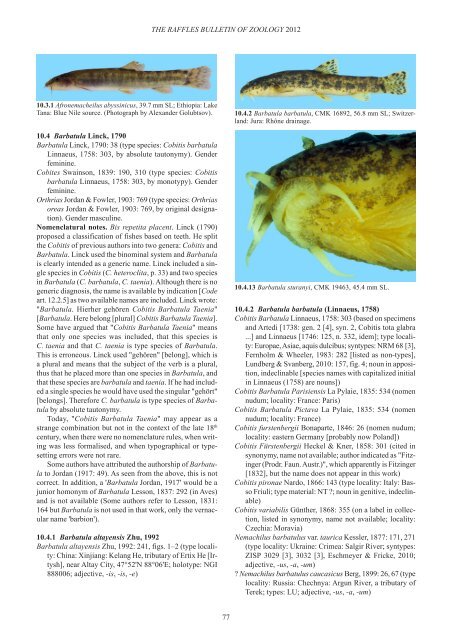Conspectus cobitidum - Raffles Museum of Biodiversity Research
Conspectus cobitidum - Raffles Museum of Biodiversity Research
Conspectus cobitidum - Raffles Museum of Biodiversity Research
Create successful ePaper yourself
Turn your PDF publications into a flip-book with our unique Google optimized e-Paper software.
10.3.1 Afronemacheilus abyssinicus, 39.7 mm SL; Ethiopia: Lake<br />
Tana: Blue Nile source. (Photograph by Alexander Golubtsov).<br />
10.4 Barbatula Linck, 1790<br />
Barbatula Linck, 1790: 38 (type species: Cobitis barbatula<br />
Linnaeus, 1758: 303, by absolute tautonymy). Gender<br />
feminine.<br />
Cobites Swainson, 1839: 190, 310 (type species: Cobitis<br />
barbatula Linnaeus, 1758: 303, by monotypy). Gender<br />
feminine.<br />
Orthrias Jordan & Fowler, 1903: 769 (type species: Orthrias<br />
oreas Jordan & Fowler, 1903: 769, by original designation).<br />
Gender masculine.<br />
Nomenclatural notes. Bis repetita placent. Linck (1790)<br />
proposed a classification <strong>of</strong> fishes based on teeth. He split<br />
the Cobitis <strong>of</strong> previous authors into two genera: Cobitis and<br />
Barbatula. Linck used the binominal system and Barbatula<br />
is clearly intended as a generic name. Linck included a single<br />
species in Cobitis (C. heteroclita, p. 33) and two species<br />
in Barbatula (C. barbatula, C. taenia). Although there is no<br />
generic diagnosis, the name is available by indication [Code<br />
art. 12.2.5] as two available names are included. Linck wrote:<br />
"Barbatula. Hierher gehören Cobitis Barbatula Taenia"<br />
[Barbatula. Here belong [plural] Cobitis Barbatula Taenia].<br />
Some have argued that "Cobitis Barbatula Taenia" means<br />
that only one species was included, that this species is<br />
C. taenia and that C. taenia is type species <strong>of</strong> Barbatula.<br />
This is erroneous. Linck used "gehören" [belong], which is<br />
a plural and means that the subject <strong>of</strong> the verb is a plural,<br />
thus that he placed more than one species in Barbatula, and<br />
that these species are barbatula and taenia. If he had included<br />
a single species he would have used the singular "gehört"<br />
[belongs]. Therefore C. barbatula is type species <strong>of</strong> Barbatula<br />
by absolute tautonymy.<br />
Today, "Cobitis Barbatula Taenia" may appear as a<br />
strange combination but not in the context <strong>of</strong> the late 18 th<br />
century, when there were no nomenclature rules, when writing<br />
was less formalised, and when typographical or typesetting<br />
errors were not rare.<br />
Some authors have attributed the authorship <strong>of</strong> Barbatula<br />
to Jordan (1917: 49). As seen from the above, this is not<br />
correct. In addition, a 'Barbatula Jordan, 1917' would be a<br />
junior homonym <strong>of</strong> Barbatula Lesson, 1837: 292 (in Aves)<br />
and is not available (Some authors refer to Lesson, 1831:<br />
164 but Barbatula is not used in that work, only the vernacular<br />
name 'barbion').<br />
10.4.1 Barbatula altayensis Zhu, 1992<br />
Barbatula altayensis Zhu, 1992: 241, figs. 1–2 (type locality:<br />
China: Xinjiang: Kelang He, tributary <strong>of</strong> Ertix He [Irtysh],<br />
near Altay City, 47°52'N 88°06'E; holotype: NGI<br />
888006; adjective, -is, -is, -e)<br />
THE RAFFLES BULLETIN OF ZOOLOGY 2012<br />
77<br />
10.4.2 Barbatula barbatula, CMK 16892, 56.8 mm SL; Switzerland:<br />
Jura: Rhône drainage.<br />
10.4.13 Barbatula sturanyi, CMK 19463, 45.4 mm SL.<br />
10.4.2 Barbatula barbatula (Linnaeus, 1758)<br />
Cobitis Barbatula Linnaeus, 1758: 303 (based on specimens<br />
and Artedi [1738: gen. 2 [4], syn. 2, Cobitis tota glabra<br />
...] and Linnaeus [1746: 125, n. 332, idem]; type locality:<br />
Europae, Asiae, aquis dulcibus; syntypes: NRM 68 [3],<br />
Fernholm & Wheeler, 1983: 282 [listed as non-types],<br />
Lundberg & Svanberg, 2010: 157, fig. 4; noun in apposition,<br />
indeclinable [species names with capitalized initial<br />
in Linnaeus (1758) are nouns])<br />
Cobitis Barbatula Parisiensis La Pylaie, 1835: 534 (nomen<br />
nudum; locality: France: Paris)<br />
Cobitis Barbatula Pictava La Pylaie, 1835: 534 (nomen<br />
nudum; locality: France)<br />
Cobitis furstenbergii Bonaparte, 1846: 26 (nomen nudum;<br />
locality: eastern Germany [probably now Poland])<br />
Cobitis Fürstenbergii Heckel & Kner, 1858: 301 (cited in<br />
synonymy, name not available; author indicated as "Fitzinger<br />
(Prodr. Faun. Austr.)", which apparently is Fitzinger<br />
[1832], but the name does not appear in this work)<br />
Cobitis pironae Nardo, 1866: 143 (type locality: Italy: Basso<br />
Friuli; type material: NT ?; noun in genitive, indeclinable)<br />
Cobitis variabilis Günther, 1868: 355 (on a label in collection,<br />
listed in synonymy, name not available; locality:<br />
Czechia: Moravia)<br />
Nemachilus barbatulus var. taurica Kessler, 1877: 171, 271<br />
(type locality: Ukraine: Crimea: Salgir River; syntypes:<br />
ZISP 3029 [3], 3032 [3], Eschmeyer & Fricke, 2010;<br />
adjective, -us, -a, -um)<br />
? Nemachilus barbatulus caucasicus Berg, 1899: 26, 67 (type<br />
locality: Russia: Chechnya: Argun River, a tributary <strong>of</strong><br />
Terek; types: LU; adjective, -us, -a, -um)

















